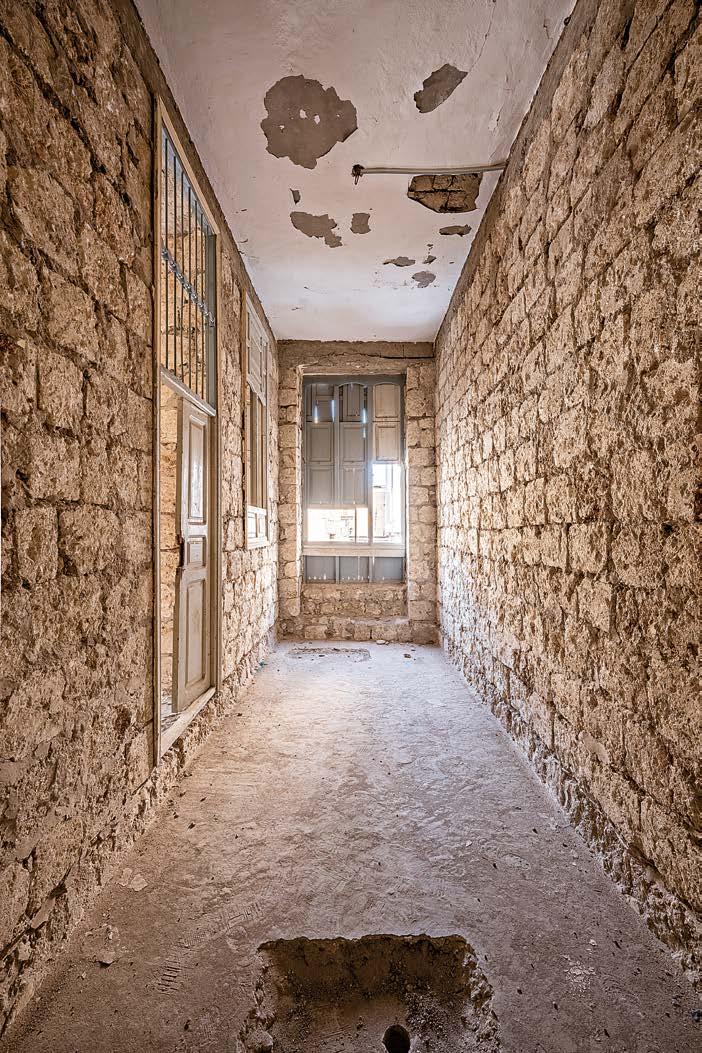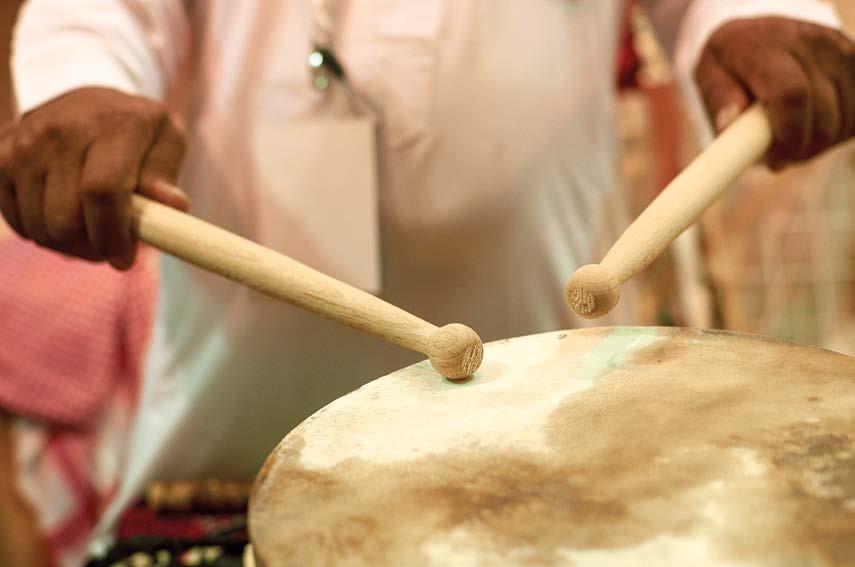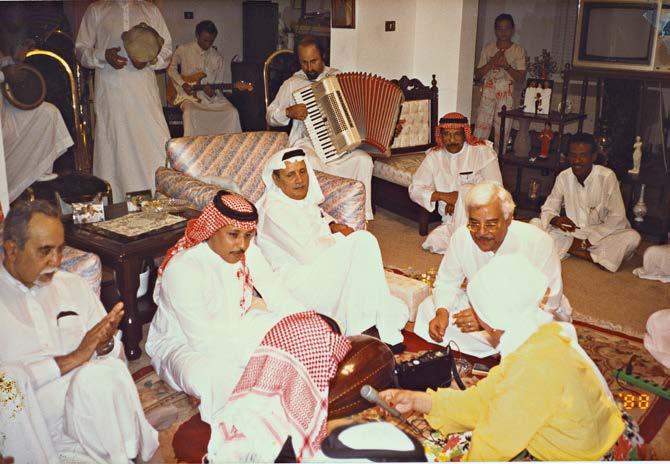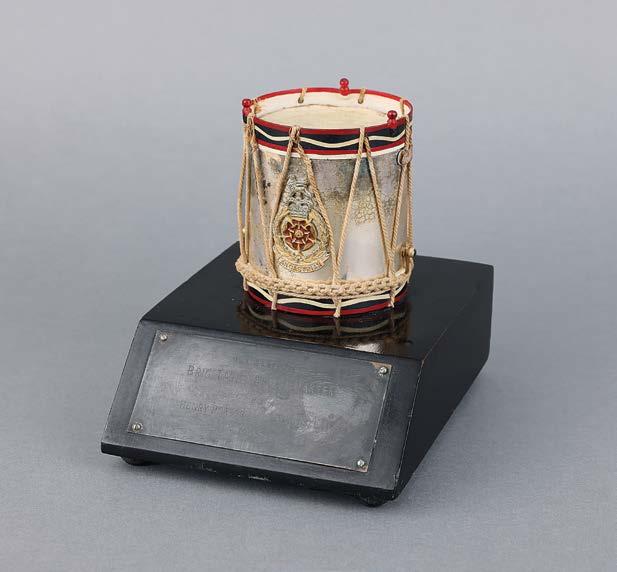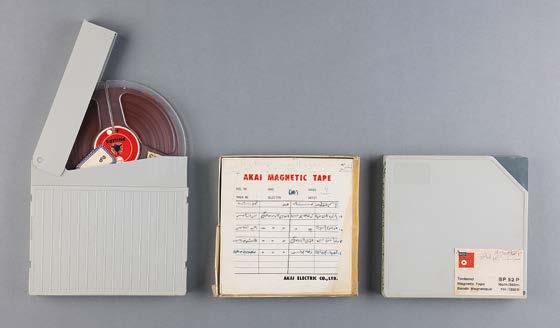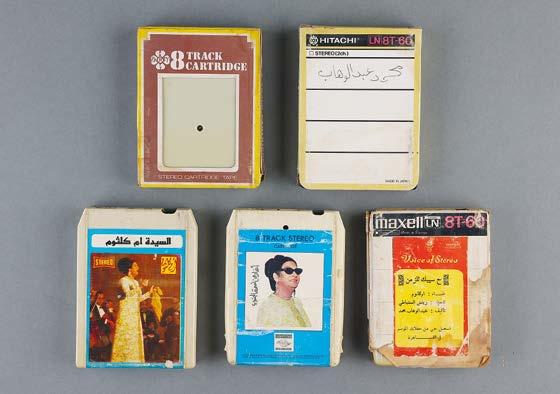CElEBRATING THE ROOTS OF TARIQ ABdUlHAKIM... TA'IF
Sa’id Al-Surayhi
Opposite:
A harmonious connection weaves through the balconies of Shubra Palace,1 the grapevines of Al Mathnah farms, and the fragrant nearby rose fields. This bond extends to the city’s picturesque scene, in which a farmer’s song resonates across the fields of Qurwa,2 where he diligently ploughs his land. The echoes of his chant gracefully intertwine with the vibrant voices of traders in the bustling markets of Barhat Ibn Abbas,3 leaving passersby enchanted by the sweet symphony. The magic deepens as swimmers in Ghadir Al Banat4 immerse themselves in the refreshing waters, blurring the line between those bronzed by the sun in the fields and those whose skin finds respite within the grand halls of the surrounding palaces.
Indeed, this is the captivating essence of the city of Ta’if.
1 Shubra Palace is a historical monument, built by Sharif Ali Bin Abdullah bin Abdulmoeen Pasha in 1905 and located in the village of Al Mathnah, which later became a neighborhood of Ta'if as the city expanded. The region is famous for its farms.
2 Qurwa is one of Ta’if’s neighborhoods. Located outside the city’s walls, it is known for its historical palaces.
3 Barhat Al Abbas is located next to Ibn Abbas Mosque. Some historians believe it is the core of the Ta’if establishment.
4 Ghadir Al Banat is a picnic area located in a sweeping valley southeast of Ta’if.
Right: Shubra Palace
Ta’if, Saudi Arabia, 2022
An orchard in AlShafa, Ta’if, Saudi Arabia, 2022
Promoting the Arts
A true pioneer of Saudi art, Abdulhakim enjoyed a diverse and illustrious career that spanned various facets of life. His journey began as a majrur-performing farmer, and it evolved as he ventured into the military realm, ultimately becoming the Director of the Army Music School as well as a distinguished figure in the traditional arts. In a significant milestone, he was elected President of the Arab Academy of Music within the League of Arab States in 1983, marking the pinnacle of his remarkable career.
Abdulhakim’s extensive background in history and aesthetic culture, coupled with his numerous musical compositions and studies, provided a solid foundation for his work at the Academy. Collaborating with its members, he dedicated himself to the vital tasks of preserving Arab musical legacy, overseeing music research and studies, fostering the expansion of musical education across the Arab World, and striving to spread traditional musical culture throughout the region.
Abdulhakim was not merely a military officer or a traditional arts enthusiast; he undertook the role of a guardian of music, protecting its cultural and aesthetic heritage, imparting it to the next generation, and ensuring that the voices of the past lived on. To him, the traditional arts transcended mere theatrical performances or isolated sounds; they were the collective memories of the people, the nation, and life itself.
In a handwritten document, bearing the letterhead of the Kingdom of Saudi Arabia, General Presidency for Youth Welfare, along with the subtitle “Ibrahim Khafaji” and centered around the theme
“The Intimate Bond Between Poet and Artist,” Tariq Abdulhakim delves deeply into the verses composed by the poet Ibrahim Khafaji for the royal anthem. He captures the essence of
In the fascinating narrative of his acquaintanceship with the poet and writer Ibrahim Khafaji, Abdulhakim reminisced, “I first crossed paths with him in Ta’if, back when he was working as a radio operator fresh out of Jabal al-Qalaa School. It all began with a song, ‘Ya Nai’s Al Jufn.’ The songs kept flowing, and our friendship grew stronger. Together, we delivered some of the most enchanting artistic performances, including the unforgettable ‘Ya Hamam Al Haram’ and ‘Ashqar wa Sha’ro Thahab,’ and we eventually moved to Riyadh, where our collaboration flourished. Al-Khafaji penned the verses, and I composed and sang.”
Abdulhakim held immense admiration for Khafaji’s poetry and words, recognizing their uniqueness in both dimension and artistic taste. The poetic expressions came to life through the artists’ performances, a phenomenon unparalleled in either recent or distant memory. He marveled at the poetic imagery that sparkled on Khafaji’s tongue as he recited and chanted alongside his fellow artists deep into the night. It was as if all the beauty, delicacy, strength, tradition, and emotional resonance of their shared heritage were woven into those verses. The amazing poet, astonishingly self-taught, had evolved into a creative force beyond measure.
Reflecting on his early collaboration with artist Mohammed Abdu, Abdulhakim recounted, “I was in Riyadh when Mr. Ibrahim Khafaji and Mr. Nasser Mohammed Jarid introduced me to a young man named Bassem Mohammed Abdu. He had previously lent his voice to other composers. He picked up the oud and sang a few of his songs for me. I was captivated by his talent and decided to collaborate. I asked Nasser bin Jarid to provide the lyrics, while I crafted the melody.” One of the songs, “Sikkat Al Tayhin,” was presented to me,
Khafaji’s words, examining their intricate layers of meaning and artistic richness.
Abdulhakim expresses his admiration for the rendition of Khafaji’s verses by the artists, a performance of
magnificence that stands unparalleled. To Abdulhakim, these words resound with brilliance on the poet’s tongue, creating a resonance that is forever immortalized within this anthem.
and Ibrahim Khafaji had earlier shared a song titled “Oh, I Never Thought in My Soul about the One There Who Is mourning.” I decided to pass it on to this young man, and he performed it on the radio. It marked the beginning of my musical journey with Mohammed Abdu.”
Abdulhakim showered praise on the pivotal role played by artist Mohammed Abdu in popularizing Arabic music. He remarked, “I greatly appreciate Mohammed Abdu’s mission, as he is dedicated to promoting Arabic music across all nations. Undoubtedly, he has attained international recognition within the Arab World. He stands as the master of Saudi and Arabic music in our time.”
Another noteworthy figure in Abdulhakim’s career was musician Abdu Mazyad, a leader in the inaugural orchestra for music on television and radio, namely, the Army Music Band, alongside colleagues Abdullah Majed and Thawab Ubaid. Abdulhakim recalled a conversation in which musicians expressing their admiration asked Mazyad where he had honed his musical skills. To their surprise, he revealed that it was at the Jabal Institute under Abdulhakim’s guidance and the Army Music School in Ta’if.
The artistic journey of Abdulhakim also intersected with several other Saudi artists, including Talal Maddah on the iconic song “Aash min Shafak,” Hassan Omar in “Bahi Al Sana,” Ramzi Atef in “Ya Sakan Al Qalbi,” Hassan Iskandarani on multiple songs, such as “Taalaq Albi,” “Ya Na’es Al Jifn,” and “Ya Layl,” and partnership with Saad Al-Hareeq and Mahmoud Ashi in songs including “Layali Al Saad,” “Ya Allah ya Wali,” and “Yeftah Allah.” These artistic unions enriched the Saudi musical landscape and left an enduring mark on the Kingdom’s cultural heritage.
Photo-collage by Tariq Abdulhakim showcasing some of the artists with whom he collaborated
While perusing the musical journals of these compositions, the pieces “Al Kalam” (“Speech”) and “Al Asrar” (“Secrets”) particularly drew my attention. Both works are set in the Al Rast maqam , commencing with the “Do” musical note repeated successively. However, a notable
Sheet music of Tariq Abdulhakim’s composition titled “Al Kalam” (“Speech”) 21 x 29.7 cm TAH 2020.167
The musical note “Do” is repeated at the beginning of the two pieces. In “Al Kalam” (“Speech”), the note repeats regularly and accelerates relatively slowly, while in “Al Asrar” (“Secrets”), it repeats faster and with turbulent frequency.
Sheet music of Tariq Abdulhakim’s composition titled “Al Asrar” (“Secrets”)
21 x 29.7 cm TAH 2020.167
distinction arises in the pace of repetition between the two. In “Al Kalam,” the speed of repetition exudes a serene quality compared to the more turbulent and rapid cadence apparent in “Al Asrar.”
Abdulhakim was nominated to represent the Kingdom at the Association of Authors, Composers, and Music Publishers in Paris in 1969; the Al-Muwashahat and Acoustics Competitions in Tunisia in the Eighth International Festival of Folklore in Carthage, Tunisia, in 1975; Palestinian song competitions in Libya in 1977; and the Gulf Song Festival in Bahrain in 1979. In 1983, he was nominated to represent the Kingdom at the Arab Academy of Music, where he later served as Deputy and then President. Additionally, Abdulhakim was nominated to represent the Kingdom at the Babylon Festival in Iraq in 1987; and in 1990, he attended the meetings of the National Institute of Music in Jordan (Nour Al-Hussein Foundation). He also represented the Kingdom at the International Council of Music (UNESCO).
A musician of exceptional talent, Abdulhakim’s contributions to Arab art are truly remarkable. His compositions stand as a proud legacy, showcasing his ability to create beautiful music alongside other giants of the art world. Furthermore, he played a pivotal and noteworthy role in enriching the cultural heritage of the Gulf and Arab World. He composed more than five hundred melodies and introduced a distinctive style to the Arab song genre. His compositions were widely appreciated, with more than one hundred male and female singers performing them. Abdulhakim’s legacy remains a testament to his enduring impact on Arab music.
Left:
Reel-to-reel tapes from Tariq Abdulhakim’s collection ca. 1950s–70s 12.7 x 12.7 cm
Above:
An interview with Tariq Abdulhakim published in Al Rasid Lebanon, 1963 From a folder compiled by Tariq Abdulhakim TAH 2020.2513
Top:
Tariq Abdulhakim with a group of friends; among them Jalal Abuzeid and Mohammed Omar
Saudi Arabia, 1988
From a photo album compiled by Tariq Abdulhakim
TAH 2020.479
Middle:
Tariq Abdulhakim with Ahmed Adawiya, Hassan Iskandrani, and Mohammed Omar
Saudi Arabia, late 1980s–early 1990s
From a photo album compiled by Tariq Abdulhakim
TAH 2020.90
Bottom:
Tariq Abdulhakim with a group of friends; among them Jalal Abuzeid, Adnan Jastaniyah, and Hassan Iskandrani
Saudi Arabia, late 1980s–early 1990s
From a photo album compiled by Tariq Abdulhakim
TAH 2020.90
Left: A letter of appreciation from HRH Prince Saif Al-Islam Al-Saud to Tariq Abdulhakim Saudi Arabia, 2001 TAH 2020.279
Opposite: A collage by Tariq Abdulhakim showcasing his collaborations with Arab artists Saudi Arabia TAH 2020.75
Minister of Finance at the time, Sheikh Mohammed Bin Suroor. Under his guidance, Abdulhakim delved into the fundamentals of playing the oud and was exposed to melodies previously unfamiliar to him. Additionally, in Makkah and Jeddah, Abdulhakim explored a wealth of singing, music, and sounds through phonographs and CDs imported from Egypt, Damascus, Yemen, Turkey, and various Asian countries. This exposure broadened his musical horizons, leading to a profound understanding of the intricacies of Hijazi song.
Abdulhakim and his Meccan companion, Jamil Mahmoud, had emerged as pioneers of Hijazi singing prior to the widespread acclaim of Talal Maddah and Mohammed Abdu. The distinctiveness of this genre can be attributed to the cosmopolitan blend of diverse musical influences brought by global artists who converged in Hijaz for religious or commercial purposes, both before and after Islam. These artists brought along their traditions, including singing, contributing to the region’s rich musical tapestry. Their numbers swelled during the Umrah and Hajj seasons, with some opting to extend their stays due to geographical proximity or a desire to remain in close proximity to Makkah and Madinah, the holy cities.
These circumstances bestowed upon him opportunities and experiences he might not have been fully aware of at the time. While such occurrences might be seen as coincidences, they also reveal the presence of an underlying, perhaps subconscious, desire guiding him toward these significant moments.
The son of a military man, Abdulhakim grew up with his father’s photo adorning the walls of their house. The image portrayed a figure with firm features, exuding seriousness, strictness, and a commanding presence. Inspired by this paternal legacy, he enlisted in the military, eventually achieving high ranks. Little did he know that his musical talents would come to the fore until the Minister of Defense at the time, Prince Mansour bin Abdulaziz, discovered his gift while Abdulhakim was still an artillery officer. This encounter marked the inception of a remarkable transformation in Abdulhakim’s life and the musical landscape of the Kingdom, particularly
Below (left to right):
Small coffee cup from the heritage collection of Tariq
TAH 2020.2516
Gift to Tariq Abdulhakim from the British Army Music Troupe by Henry Potter & Co. Drums Ltd. United Kingdom, 1965 Wood and metal, 15 x 15 cm TAH 2020.2507
Abdulhakim
Top to bottom:
Audio reel-to-reel tapes from the collection of Tariq Abdulhakim ca. 1950s–70s
Selection of cartridge tapes from Tariq Abdulhakim’s collection
Briefcase filled with watches and prayer beads from the collection of Tariq Abdulhakim TAH 2020.32
AN INSPIRATION FOR GENERATIONS
Majed Al-Ahdal
A nation not concerned with recording and archiving the achievements and contributions of its people and which does not verify the truth of a great person within sixty years of his death is considered a nation with a weak sense of history.1
Inspiration is a complex concept often debated by philosophers, theologians, and psychologists. Intellectuals contemplate the notion of inspiration, seeking to uncover and elucidate its sources, interpretations, and nature. When pondering this concept, the story of Tariq Abdulhakim comes to mind. A national icon, Abdulhakim skillfully revitalized the rich heritage of the Kingdom of Saudi Arabia, becoming the inaugural ambassador of Saudi song to the Arab World and beyond. His life brimmed with numerous challenges and achievements, making his journey a wellspring of inspiration for generations to come.
To delve into the inspiring journey of Abdulhakim, we will navigate through the various stages of his life, spanning nearly a century. We will illuminate the diverse events and milestones, commencing with his childhood. The narrative will encompass his personal account, as well as perspectives from contemporaries, students, and admirers. Abdulhakim lived through significant political transformations, witnessing the establishment of the third Saudi state following its unification by the late founder, King Abdulaziz bin Abdulrahman Al-Saud. During this period, many governmental institutions in Saudi Arabia were in the process of establishment and development, making the role of creatives pivotal and challenging as they paved the way for future generations. Abdulhakim’s contributions to the art scene in Saudi Arabia are noteworthy, encompassing the establishment and global promotion of Saudi music and the founding of the first Saudi Army Music Institute. These achievements were the result of his tireless efforts, unwavering determination, and deep national commitment that ignited his initial inspiration. In various television and press interviews, Abdulhakim consistently emphasized the crucial role of creatives and artists in drawing inspiration from the national sentiment.2
Opposite: Copenhagen Youth Festival diploma awarded to the Saudi traditional performing arts group led by Tariq Abdulhakim Denmark, 1975
30 x 24 cm TAH 2020.1251
1 Oswald Spengler, The Decline of the West, vol. 1, 13–14; as cited in Abbas, Fan Al Sira (Beirut: dar Sader Publishers, first edition), 9.
2 Tariq Abdulhakim, Oghneyat Al Watan Program on Saudi Television, presented by Jaber Al-Qarni.
Tiphaine Massari
The Tariq Abdulhakim Museum and this accompanying publication were developed by the Museums Commission, Ministry of Culture of Saudi Arabia in December 2023.
Collection on Display
Most items on display are from Tariq Abdulhakim’s collection and owned by the Museums Commission, Ministry of Culture, Saudi Arabia
The military musical instruments were gifted to the Tariq Abdulhakim Museum by Dr. Lisa Urkevich. Cover Image Design
Publication
Edited by the Museums Commission, Ministry of Culture, Saudi Arabia and Silvana Editoriale
Project Management
Museums Commission, Ministry of Culture of Saudi Arabia Hala Abuzeid
Dr. Virginia Cassola Yussor AlKhateeb
with the support of Jumaah Albosaad, Yara Bana, and Attia Alrajhi
Special Thanks Hassan Iskandrani for his participation in writing some of the publication texts (pp. 58, 70, 76, 90, 91, 106, 116, 152, 166, 190, 192, 204)
Tashkeel publishers for editing the Arabic articles
Silvana Editoriale
Chief Executive
Michele Pizzi
Editorial Director
Sergio Di Stefano
Art Director Giacomo Merli
Editorial Coordinator
Maria Chiara Tulli
Copy Editor
Cristina Pradella
Translations
Mayadin Art: Ismail Rifai, Lien Sulaiman, Lojain Ibrahim, and Dalia Masri
Layout
Evelina Laviano
Production Coordinator Antonio Micelli
Editorial Assistant
Giulia Mercanti
Photo Editor
Silvia Sala
Press Office
Alessandra Olivari, press@silvanaeditoriale.it
All reproduction and translation rights reserved for all countries
© 2025 Museums Commission, Ministry of Culture, Saudi Arabia
© 2025 Silvana Editoriale S.p.A., Cinisello Balsamo, Milano
Under copyright and civil law, this book cannot be reproduced, wholly or in part, in any form, original or derived, or by any means: print, electronic, digital, or mechanical, including photocopy, microfilm, film, or any other medium, without permission in writing from the publisher.
The Ministry of Culture, Saudi Arabia King Faisal Road
Al Diriyah, P.O. Box 3424
13711 Riyadh, Kingdom of Saudi Arabia www.moc.gov.sa
Silvana Editoriale S.p.A. Via dei Lavoratori, 78 20092 Cinisello Balsamo, Milano, Italy Tel. 02 453 951 01 www.silvanaeditoriale.it
Reproductions, printing, and binding in Italy
Printed by Tipo Stampa S.r.l., Moncalieri (Torino) in May 2025
Photo Credits © Christophe Martin: p. 16
© King Abdulaziz Foundation for Research and Archives / Princess Alice: p. 54
© Ministry of Culture, Saudi Arabia, TKANH / Husain Alahdal: pp. 16–17, 40–51, 55
© Ministry of Culture, Saudi Arabia, TKANH / Emad Alhusayni: pp. 17–19
© Ministry of Culture, Saudi Arabia, TKANH / Waddah Mudarris: p. 16
© Ministry of Culture, Saudi Arabia, Arif Alnomay: p. 96
© Ministry of Culture, Saudi Arabia, TKANH / Mustafa Baltu: p. 17
Courtesy of Perihan Tariq Abdulhakim: pp. 175–176
Courtesy of Ali Al-Nemr (Ali Fakandash): p. 89
Courtesy of Ronan Olier’s Family: p. 56
Courtesy of Olivier Couppey: p. 68






